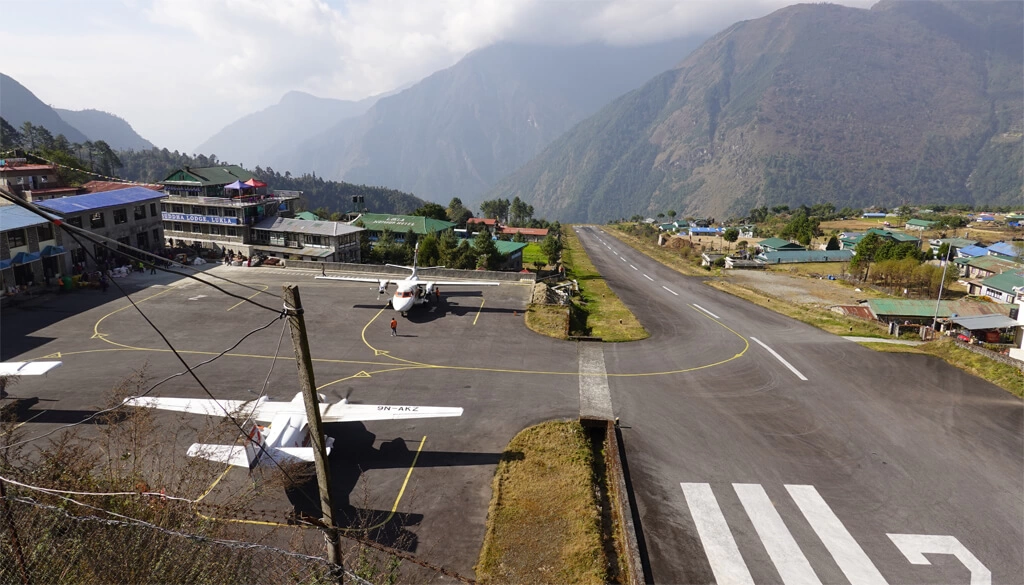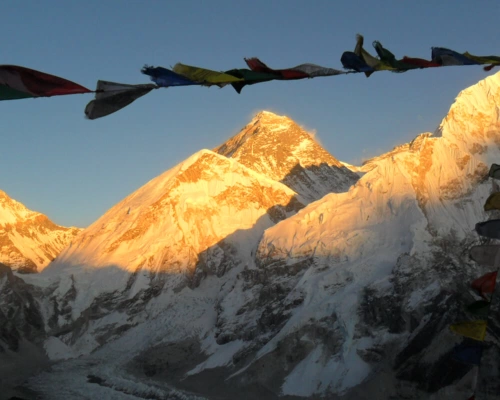Departure Note:
Guaranteed - We already have trekkers booked for those dates and you can join the group.
Available - The date is available to book and once you confirm your trip it will be guaranteed.
Limited - The departure date is filling fast and only limited seats are available to join.
Closed- The Trip cannot be booked on that specific date. Contact us for customized dates.
The departure dates are your arrival dates in Nepal.
We have set dates for departure to the Everest Base Camp Heli Trekking. So, pick your preferable date and let the adventure begin.
Everest Base Camp Heli Trekking is available and can be done throughout the year. So, if the date you prefer is not listed on our departure dates then you can contact us directly to book the trip on your own desired date.
We have listed the price up to12 trekkers at maximum. If you are more than 12 trekkers, then please feel free to contact us for amazing discounted group price and further booking process.
Private Trips to Everest Base Camp Heli Trekking is possible on any date of the year. Contact us to design you own private trips with you loved ones.
Solo Trips: Single trekkers are always welcome to join the trek. On your arrival at Kathmandu, you’ll have a single room in Kathmandu Hotel as per your requirement and have to share a room at the local teahouses during the trekking.
Useful Info
Everest Base Camp with Helicopter Return Trek Packing List:
Are you planning your dream trip to the Himalaya of Nepal? Make sure you have packed well for your hiking and trekking experiences in Nepal. The time period of your visit also determines your packing list. The best trekking seasons for beginning your Everest Base Camp with Helicopter Return Trek are spring and autumn. During these seasons, maximum flow of trekkers can be witnessed. Weather during spring (March – May) and autumn (September – November) are likely to be mild with clear blue sky and outstanding mountain views. But nights can get freezing cold at higher elevation. So, packing appropriate clothing, gear, and equipments for your Everest Base Camp with Helicopter Return Trek is a must for lifetime memorable trekking experience in Everest region of Nepal.
Here is the complete packing checklist for Everest Base Camp with Helicopter Return Treking or any other similar teahouse trekking in the captivating Himalaya of Nepal.
Upper Body:
- Warm beanie hat
- Tubular Headwear (buff)
- Sun Hat or Cap (cap and buff all fit under your hood)
- Polarized Sunglasses with UV protection
- Headlamp (Black Diamond / Petzl) with spare batteries
- Sunscreen with factor 50+
- Upper Body (Core body):
- 3 Light and trekking weight thermal tops
- 3 T-shirts or cool-max trekking shirts
- 1 Fleece Jacket
- 1 Waterproof shell jacket with hood (lightweight, breathable)
- 1 Down Jacket
Lower Body:
- 2 Thermal base layers (merino or polartec power dry)
- 2 Pairs trekking pants, preferably that zip on/off at the knees so they double as shorts.
- 1 Heavy weight hiking trousers (wind proof soft shell for warmth at higher altitude)
- 1 Waterproof/ Rain pants
- 1 Fleece Pants
- 4 Under wears (merino)
Hands:
- 1 Lightweight gloves or liner gloves
- 1 Pair shell gloves (Gore-Tex)
Feet:
- 3 Warm Trekking socks (smart wool)
- 3 Pairs of liner socks
- 2 Pairs of thick/ warm socks
- 2 Thick wool socks to wear at night in lodges
- Trekking Boots (waterproof, ankle support with rigid sole)
- Lightweight Rubber Shoes / Trainers / Trail Runner to wear at the Tea Houses
Accessories:
- 1 Daypack (approximately 2500 to 3000 cubic inches) 40 - 50 Liters
- 2 Water bottle or camel bag, 1-liter (one with an insulated cover is recommended)
- Large duffle bag (and a lock as the porters will carry this)
- A pair of adjustable Trekking Pole
- Camera with extra battery
- Sleeping bag (- 15 C depending upon trips)
- Sleeping Bag liner
- Ear Plugs
- Portable Solar Charger
- Smart Trekking Watch
Personal First Aid Kit:
Please do note that our trekking guides will be too carrying the first aid kit with them especially for the guests and the entire team as a whole. Still, we suggest the following items to be carried with you while trekking in the Himalaya of Nepal.
- Personal Medication
- Diarrhea Stopper (e.g. Imodium)
- Paracetamol Tablets
- Small Swiss Army knife (which has knife, scissors and tweezers)
- Diamox for altitude (consult your doctor about this)
- Water Purification tablets or drops
- Blister kit / Zinc Tape
- Hand Sanitizer
- Dressing Gauze
- Antibiotic Cream
Can Everest Base Camp Trekking be done throughout the year?
Yes. Everest Base Camp trekking can be done throughout the year. However, the accepted answer to this, stating the best seasons for doing Everest Base Camp Trekking are from March to May (Spring) and September to November (Autumn). During these months, weather remains stable with clear blue sky offering us the surreal views of mountains soaring high. The summer months from June to August are also beautiful but the trek can be affected by the monsoon rains. Winter season (December to February) can be a great period for trekking to Everest Base Camp with good preparations, proper clothing and pre - arrangements for cold and weather.
Everest Base Camp Trekking in Spring (March – May)
Spring season (March – May) is the perfect time to do the Everest Base Camp trekking in Nepal and to experience the adventure to the foothills of world highest mountain, Mount Sagarmatha (8848.86m). Spring season offers magnificent views, mild temperature, and remarkable adventure experiences. This season succeeds winter because of which first weeks of March will be quite cold. After that, temperature begins to warm up at Everest region and small buds of grasses start blinking from the ground. Spring is the season where most of the biodiversity blossoms up again and we witness varying species of flora and fauna along the trekking trail. Temperature on a normal day ranges from 10 – 14 degrees and at night temperature can drop upto 3 degrees. Undoubtedly, spring season is a joyful time for beginning Everest Base Camp trek.
Everest Base Camp weather in Monsoon (June – August)
Early June marks the start of Monsoon (Summer) and ends by the end of August. The summer months from June to August are also beautiful, but the trek can be affected by the monsoon rains. Monsoon is regarded as off season for trekking in Everest region including Everest Base Camp too. However, trek to Everest Base Camp is still possible. As the name implies, summer (monsoon) days are hotter. So, we suggest wearing lightweight T-shirts and shorts while hiking. Monsoon indicates heavy rainfall and unclear surroundings which stands as an obstacle for getting a clear view of Khumbu Himalaya. Also, the trekking trails become wet and slippery due to frequent rain. The frequent rainfall in monsoon makes the EBC trek more difficult and because of rain, mosquitoes and leeches are found everywhere during this season. Temperature on a normal day ranges from 15 and reach up to 22 degrees and during night, temperature falls down to 5 degree to 0 degree (max).
Everest Base Camp Trekking in Autumn (September – November)
Following spring, Autumn (September – November) is the ideal season for Everest Base Camp trekking. September, October and November falls under this season. These months are known for sunny and warm weather and stable and outstanding mountain views. Autumn rewards the outdoor enthusiasts with a pleasant afternoon temperature for hiking. Nights get colder as we gain elevation but it is endurable. During autumn, you’ll witness some of the best views of towering Himalayan peaks dominating the Khumbu valley. Thousands of trekkers visit Everest Base Camp in this season as autumn probably has the favorable trekking weather and conditions. Even in autumn season, October is the busiest month for trekking in Everest Base Camp. Days are balmy and temperature in afternoon ranges to 12 – 15 degrees. During the night, temperature drops down to below zero degree on high altitudes (above 3500m).
Everest Base Camp weather in winter (December – February)
“There's no such thing as bad weather, only unsuitable clothing.” - Alfred Wainwright
With proper clothing, proper acclimatization and experienced Sherpa team, Everest Base Camp Trekking can be done. Winter season is for sure, the coldest time in Everest region of Nepal. The cold wind brings freezing temperatures and infrequent heavy snowfalls. However, winter season (December to February) can be a great period for trekking to Everest Base Camp with good preparations for cold and weather.
Trek to EBC will more adventurous yet rewarding. With proper winter gears, Everest Base Camp trek in winter is still doable and one can have a remarkable experience at Everest during winter. Winter days are shorter and nights are freezing cold and longer too. You might witness and need to pass through heavy snow on the trails. The sections involving jagged ascents, descents, and crossing the passes are more trick and challenging. February is considered as the coldest month of winter time in Everest. Temperature on a normal day ranges from 6 to 8 degrees and during night, temperature falls down to -15 degree (max.). Therefore, you need to carry extra warm gears and safety measures for Everest Base Camp trekking in winter.
Guaranteed Departure for Everest Base Camp Trekking
We’ve added Everest Base Camp Trekking fixed departure trek dates for Autumn, 2023 and Spring and Autumn, 2024. So, pick your preferable date and allow us to assist you to the foothills of worlds’ tallest mountain, Mount Everest (8848.86m). Everest Base Camp Trekking is available and can be done throughout the year. So, if the date you prefer is not listed on our departure dates then you can contact us directly to book the trip on your own desired date. We have listed the price up to 12 trekkers at maximum. If you are more than 12 trekkers, then please feel free to contact us for amazing discounted group price and further booking process.
Likewise, if you’re a Female Traveler and you wish to get a departure date in any of the trekking categories that is, in a group, or solo in a private trekking group, we can also manage that for you. Private Trips to Everest Base Camp is possible on any date of the year. Contact us to design your own private trips with you loved ones. Single trekkers (Solo Travelers) are always welcome to join the trek. On your arrival at Kathmandu, you’ll have a single room in Kathmandu Hotel as per your requirement and have to share a room at the local teahouses during the trekking.
















